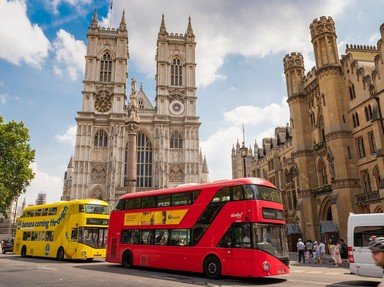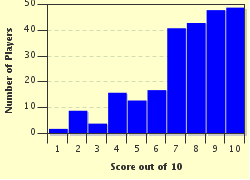Quiz Answer Key and Fun Facts
1. Westminster, today known for the Houses of Parliament, Big Ben, the Abbey and most major government offices, was originally put on the map by Edward the Confessor, who built a royal palace in the countryside outside the walls of the City of London. He also built Westminster Abbey, which was consecrated in 1065. William Rufus (1087-1100) built Westminster Hall, outside Westminster Palace, which was the setting for many state trials. What was, arguably, the most famous or infamous of these trials?
2. Now the home of Madame Tussaud's and Baker Street, the St. Marylebone area of London, northwest of the original walled city, had been a deer park in the reign of Elizabeth I. Under James I the southern part was let out in small holdings for dairy and hay production. The name is mistakenly thought to have been a distortion of the Church name of St. Mary Le Bon (Mary the Good). In fact the name is a contraction of St Mary on the Bourne, the Bourne being one of a myriad of streams that still flow under London streets.
The manor was purchased by the Duke of Newcastle in 1710 for £17,500. The property was then inherited or passed on through marriage to family names such as Cavendish, Portland, Wigmore, Harley and Bentinck. All these names appearing on today's streets in the area.
There is one street, that today is famous for many large Victorian and Edwardian houses, containing the consulting rooms of Britain's finest physicians and surgeons, attracting patients from all over the world. What is the name of this renowned street?
3. Continuing on a northwestern direction, we encounter the fashionable and rather pricey St. John's Wood area. Once part of the Great Forest of Middlesex, the land was owned by the Order of St. John of Jerusalem, an Augustinian order that took over the land in 1323 from the Knights Templar. With the dissolution of the monasteries under Henry VIII, the land became the property of the Crown.
It remained a mainly rural area until early in the 19th century, when it was turned over to pleasant villas with large gardens and many tree-lined streets. It became a much sought-after address offering some rural charm so close to the center of London. In 1814 a famous sports ground was relocated to the area, becoming the official home of which sport?
4. Moving further north and up the steep hill of today's Fitzjohns Avenue we reach the still quaint area of Hampstead Village. Originally settled by the Saxons the name comes from the Saxon 'ham stede', meaning home farm.
The village area began to be greatly developed from the late 17th century on, when wealthy citizens sought the clean air of the hill-top, away from the dirt, noise and disease of the City.
Stage coaches running North from the original city would stop at one of the many inns and pubs still in existence. In particular the Spaniard's Inn has been linked forever with the story of Dick Turpin. For what was he famous, or infamous?
5. A little further north, yet joined to Hampstead by the extended stretches of Hampstead Heath, we come upon Highgate Village, set atop a steep hill with spectacular views down to the city below.
Originally part of the Bishop of London's hunting estate, the village is also home to Highgate School, originally founded by permission of Elizabeth I in 1565.
Its famous Victorian, somewhat Gothic, cemetery is known for many of its A-list permanent residents. Who is one of its surprising long-time silent villagers, a long way from any Russian connections.
6. We now follow the River Thames going upstream for a little over three miles from the original London Bridge until we reach Chelsea. The name comes from an Anglo-Saxon word meaning 'chalk wharf', and it had been a place where chalk and stones were downloaded. The existence of the manor of Chelsea precedes the Domesday Book. During the reign of Edward the Confessor the land was given to the Abbott and Convent of Chelsea, the Abbot in turn giving it to his mother, from whom it passed into private ownership. Various monarchs from Henry VIII on through Charles II built many fine houses in the area. So that by 1695 it was described as a 'village of palaces'. The best-known building is the Royal Chelsea Hospital, built by Charles II, home to the Chelsea Pensioners. What special event is held every spring in the grounds of the Royal Chelsea Hospital?
7. Another ancient area of London, the home of Harrods department store, is now fashionable Knightsbridge. Originally, as the name suggests, not a village, but a location close to a bridge. Legend has it that a body of knights, in the middle ages, were traveling to seek a blessing from the Bishop of London at Fulham Palace. A disagreement broke out among them while they were crossing the bridge and a skirmish ensued, the area ever know thereafter as Knightsbridge. The village around Knightsbridge remained unexceptional. The main road west out of London passed through its center, and was a lucrative spot for several generations of unscrupulous highwaymen. The area expanded somewhat during the 18th century as it was an area known for its good air. It was the relocation of Tattersall's Auction House to the center of Knightsbridge that changed the area forever. What, in particular, was Tattersalls well known for auctioning?
8. The area that is today known as Clerkenwell dates from the early 12th century, having grown up around the Benedictine nunnery of St Mary and the priory of John of Jerusalem.
Smithfield meat market has been an important part of the area since Saxon times, when the stench of the meat market and its residue forced them outside the city walls. Yet Clerkenwell was well known for its many religious institutions, giving the area some prominence. The Bible Story was peformed annually.
The River Fleet flowed through Clerkenwell, creating a plentiful source of clean water for a local spa, as well as the sports of angling and duck shooting. It was also home to one of the largest Gin distilleries in the country.
In the 18th century as the well-to-do moved further out, the area became taken over by traders, artisans and skilled craftsmen, and brewers. Still today a major brewer in the area sends out the dray cart for beer barrel delivery pulled by four magnificent shire horses in full livery.
It is this busy trading atmosphere that attracted many writers to live in the area to get a true sense of London and Londoners. Which writer in particular is ever linked to the area, having lived in there at different times, over his lifetime?
9. The Soho district of London with its many fine restaurants, jazz and blues clubs and a preponderance of nasty porn was, back in Henry VIII's time a rural idyll and part of the King's Hunting ground. A lease was subsequently granted to Henry Jermyn, 1st Earl of St Albans The Earl then sublet 19 of the 22 acres to Joseph Girle, with permission to build. The first lease granted for the building of a brick factory. This was the start of development in the area and the end forever of the rural setting.
The intention had been to ultimately develop the area with fashionable houses in the same grand scale as Mayfair, Marylebone and Bloomsbury. However the plan failed and the wealthy homeowners that had settled in Soho, sold up and moved to greener pastures. As a result, the area began to fill with an immigrant population, still apparent today by the various ethnicities of restaurants, grocery stores and trades such as tailoring, after which taverns and brothels moved in.
After the Second World War Jazz and Blues clubs began to appear. Which club, from its earliest days has established a reputation for excellence in the quality and variety of musicians they have presented?
10. Originally the area of London today known as Bloomsbury, was mentioned in the Domesday book as an area of vines and 100 pigs. A Norman landowner in 1201, a William de Blemond acquired the land, which was known as Blemondisberi - the bury or manor of Blemond, from which the name Bloomsbury gradually developed.
At the end of the 14th century the land was acquired by Edward III from Blemond's Manor and passed it on to Carthusian monks. After the dissolution of the monasteries, Henry VIII presented the land to the Earl of Southampton. The earl began some building, but the main design and construction of the area was created by Francis Russell, fifth Duke of Bedford. His plan was, among other things to build garden squares of large family homes, together with an area filled with parks and open spaces.
In the 19th and 20th centuries Bloomsbury became a sought after location for many of the great writer and artists of the day. Which writer of English novels has become particularly synonymous with Bloomsbury?
Source: Author
Englizzie
This quiz was reviewed by FunTrivia editor
bloomsby before going online.
Any errors found in FunTrivia content are routinely corrected through our feedback system.

